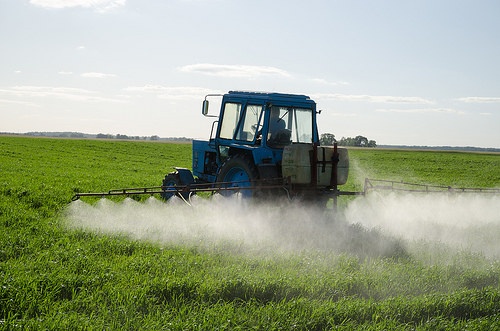On April 26, 2018, the Ontario government passed the Pay Transparency Act, 2018 (the Act), which created a number of requirements for employers with respect to compensation reporting and disclosure to employees and potential employees, as well as compliance compensation reporting to the government, which the government will then make public.
Read MoreAudit, Compliance and Risk Blog
Tackling the Gender Pay Gap: Ontario’s Pay Transparency Act, 2018
Posted by Maria Gergin on Tue, Oct 30, 2018
Tags: Business & Legal, Employer Best Practices, Employee Rights, Canadian, directors, directors & officers
Organizations with facilities that may be subject to routine water infiltration or leaks, or sudden flooding from hurricanes or other events – should consider both sets of information.
Mold Basics
Molds and other fungi are both ubiquitous and plentiful--they have been estimated to make up a quarter of all the biomass on the planet. Molds are found almost everywhere, and can grow on just about any surface, as long as moisture and oxygen are available.
Read MoreTags: Employer Best Practices, Health & Safety, Employee Rights, Environmental risks, Environmental, mold
The Occupational Safety and Health Administration (OSHA) and state worker protection agencies require employers to identify regulated carcinogens in their workplaces, to protect workers against hazardous exposures, and to provide information and training to reinforce those protections. OSHA regulations apply to dozens of chemical agents and other substances known to be human carcinogens, including 13 covered by a single “Regulated Carcinogen Standard.” Employers should also be aware that hundreds of additional chemicals are suspected carcinogens that should be considered.
Read MoreTags: Employer Best Practices, Health & Safety, OSHA, Employee Rights, Environmental risks, Environmental, Hazcom
EPA Schedules Compliance Deadline for Revised Agricultural Worker Training Requirements
Posted by Jon Elliott on Tue, Jul 24, 2018
In November 2015, the Environmental Protection Agency (EPA) adopted significant amendments to the Agricultural Worker Protection Standard (WPS) that EPA administers using its Federal Insecticide Fungicide and Rodenticide Act (FIFRA) authority -- FIFRA provides national pesticide regulation, and the WPS is intended to ensure that workers know how to protect themselves when applying pesticides. EPA set compliance deadlines for most revised provisions on January 2, 2017 or January 2, 2018, but left the compliance deadline for expanded training open until the agency could develop and publish training materials. On June 22, 2018, EPA published notice that these materials are ready, giving employers until December 19 to upgrade their training programs accordingly.
Read MoreTags: Employer Best Practices, Employee Rights, Training, Environmental risks, Environmental, EPA, Hazcom
-
In isolated areas of the employer’s workplace - such as a security guard making rounds at a site, or a miner in an isolated area.
-
At times when no co-workers are around - such as a late-working professional; a night janitor, nurse or security guard making rounds; or a hotel room service worker.
-
As the sole employee at a facility - such as late-night retail gas station or convenience stores.
-
Away from the home office, separated from co-workers and exposed to customers or others - law enforcement or security personnel on patrol, home-care health and social workers, taxi drivers, and traveling sales personnel.
Although isolation makes it inherently harder to protect these workers from harm and to respond to any incidents, employers still must provide them with reasonable levels of protection from workplace hazards. The following discussion synthesizes guidance from national agencies, and specific requirements adopted by a few jurisdictions to protect employees working alone or in isolation.
- Who is “working alone?”
Definitions of “working alone” vary, but each incorporates some or all of the following circumstances:
• Worker is the only worker for that employer at that workplace, during any time period.
• Worker is not directly supervised, during at least part of work shift.
• Assistance is not readily available if there is an emergency.
• Conditions render this isolation potentially hazardous.
- What employer actions can help?
Specific requirements that employers provide for isolated employees’ safety vary. For example, Manitoba requires the employer to:
-
Identify risks arising from the conditions and circumstances.
-
“So far as is reasonably practicable,” take steps to eliminate or reduce the identified risks.
-
Develop and implement safe work procedures to eliminate or reduce the identified risks.
-
Train workers in these safe work procedures.
- Ensure that workers comply with these safe work procedures.
- What are specific examples of workplace safety measures?
Workplace responses depend on circumstances. For example, if the isolated employee works in a single location, the location and workshift can be designed to reduce hazards. For example, New Mexico requires at least one of the following security measures be implemented in all convenience stores operating between 11 p.m. and 5 a.m.:
-
Two-employee shift - two employees, or one employee plus onsite security personnel.
-
Controlled access area - this area must be behind bullet-proof glass or other similar material.
-
Pass-through window - transactions must be protected by bullet-proof glass or other similar material.
-
Alternative operations - the store may be closed for business, but employees allowed access for restocking or other duties, if signs are posted on all entryways saying the store is closed.
In other situations where the employee travels, for example to conduct a service or security sweep, there’s no single space to isolate but enhanced communication can reduce hazards. For example, Chicago’s new ordinance (dubbed the “pants on, hands off” requirement) requires hotels to do the following:
-
Develop, maintain and comply with a written anti-sexual harassment policy to protect employees against sexual assault and sexual harassment by guests, including instructions to leave threatening situations if possible, reporting procedures, onsite incident follow-up (immediate, and subsequently with law enforcement if applicable), and training regarding these procedures and employee rights (effective January 7, 2018).
-
Provide all employees with a current copy (in English, Spanish and Polish) of the hotel's anti-sexual harassment policy, and post copies in conspicuous places in areas of the hotel, such as supply rooms or employee lunch rooms (effective January 7, 2018).
-
Equip employees who are assigned to work in isolation in a guest room or restroom with a panic button or notification device (effective July 1, 2018)
Self-Assessment Checklist
Has the organization assessed work assignments and its facilities, to identify workers who may work alone or in isolation?
-
Are these assignments routine and ongoing, or infrequent?
-
Does the location contain inherent hazards (stairs, operating equipment, etc.) where mishaps or malfunctions can cause hazards?
- Are the employees isolated from outside interventions (e.g., in a secured facility) or subject to interaction with outsiders (customers, clients, etc.)?
Has the organization identified specified hazards and their causes, and evaluated risk reduction measures?
-
Monitoring systems?
-
Staffing?
-
First aid and emergency procedures?
- Workplace violence?
Has the organization developed risk reduction policies, plans and procedures?
Does the organization provide training and equipment to affected employees?
Where Can I Go For More Information?
Specialty Technical Publishers (STP) provides a variety of single-law and multi-law services, intended to facilitate clients’ understanding of and compliance with requirements. These include:
About the Author
Jon Elliott is President of Touchstone Environmental and has been a major contributor to STP’s product range for over 25 years. He was involved in developing 13 existing products, including Environmental Compliance: A Simplified National Guide and The Complete Guide to Environmental Law.
Mr. Elliott has a diverse educational background. In addition to his Juris Doctor (University of California, Boalt Hall School of Law, 1981), he holds a Master of Public Policy (Goldman School of Public Policy [GSPP], UC Berkeley, 1980), and a Bachelor of Science in Mechanical Engineering (Princeton University, 1977).
Mr. Elliott is active in professional and community organizations. In addition, he is a past chairman of the Board of Directors of the GSPP Alumni Association, and past member of the Executive Committee of the State Bar of California's Environmental Law Section (including past chair of its Legislative Committee).
You may contact Mr. Elliott directly at: tei@ix.netcom.com
photo credit: spanaut winning via photopin (license)
Read MoreTags: Employer Best Practices, Employee Rights, Workplace violence
Tags: Business & Legal, Employer Best Practices, Employee Rights
There are no national ergonomics requirements for employers, but California has just expanded its longstanding requirements, to add specific protections for hotel housekeepers. These new requirements complete review and rulemaking triggered in 2012 by a petition by a labor advocacy group, and are consistent with other requirements already administered by the state Division of Occupational Safety and Health (CalOSHA). The state’s efforts are also consistent with general guidance provided US Occupational Safety and Health Administration (OSHA). (OSHA has enforced its General Duty Clause against employers found to have ignored known hazards to their employees, since President Bush signed legislation in 2001 repealing OSHA’s own national ergonomics standard.).
Read MoreTags: Employer Best Practices, Health & Safety, OSHA, Employee Rights
Automated External Defibrillators (AEDs) are appearing in more and more public spaces and workplaces. These electronic devices are designed to deliver an electric shock to a victim of sudden cardiac arrest, and could save thousands of lives every year:
Read MoreTags: Employer Best Practices, Health & Safety, OSHA, Employee Rights, AED
Does Sex Discrimination Include Sexual Orientation – The Second Circuit Changes Sides
Posted by Jon Elliott on Tue, Apr 24, 2018
Because federal anti-discrimination statutes include “sex” discrimination but do not define the term, its interpretation evolves with social and political changes, with policy changes by the Equal Employment Opportunity Commission (EEOC), which administers and enforces Title VII of the Civil Rights Act of 1964 and a variety of subsequent laws, and with court decisions. A major present debate is whether “sex” encompasses “sexual orientation” – which would protect non-heterosexual employees against employment action based on their sexual orientation. On February 26, 2018 the Second Circuit Court of Appeals reversed its own precedent, and decided that homosexual employees are protected.
Read MoreTags: Employer Best Practices, Employee Rights, Workplace violence, EEOC, directors, directors & officers
Ninth Circuit: Salary History Doesn’t Justify Male-Female Pay Disparities
Posted by Jon Elliott on Tue, Apr 17, 2018
On April 9, a majority of the Ninth Circuit Court of Appeals ruled that an employer cannot rely on newly-hired employees’ salary histories to justify paying men more than women for the same work. Although the federal Equal Pay Act of 1963 allows disparities based on factors “other than sex,” the court found that salary histories are sufficiently tainted with sex discrimination to bar such reliance. Since it’s taken over 50 years for an appeals court to reach this conclusion, it’s worth exploring the court’s reasoning.
Read MoreTags: Employer Best Practices, Employee Rights, directors, directors & officers










